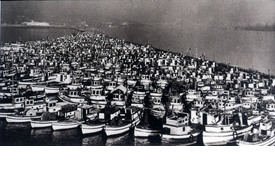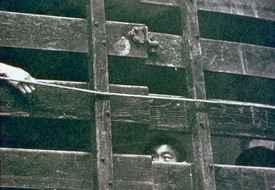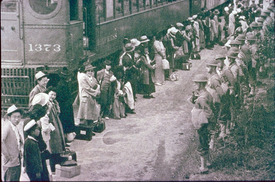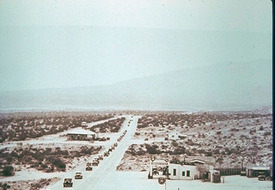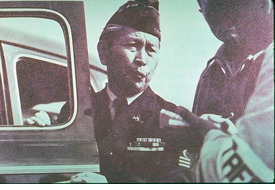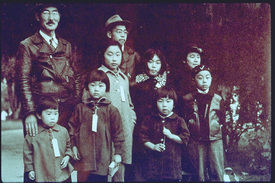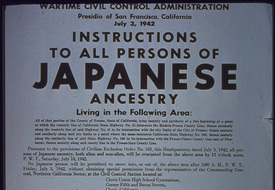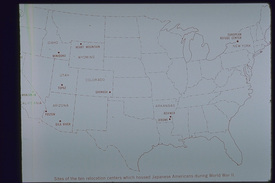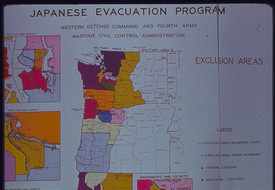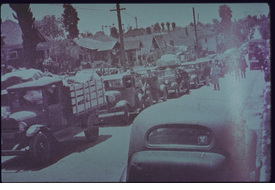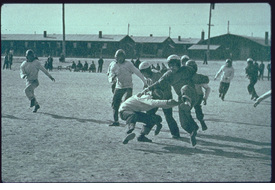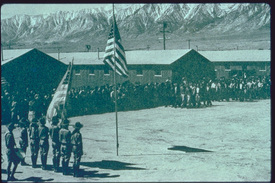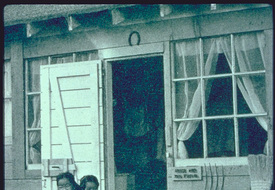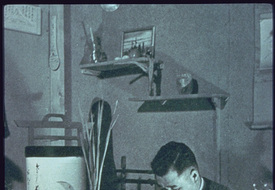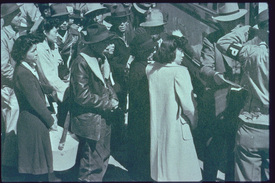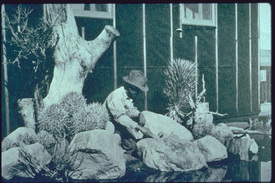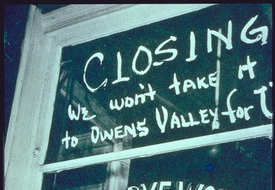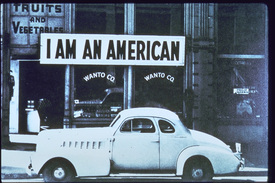Confiscated Japanese-Canadian Fishing Boats, 1942
Image ID: 14408
Collection: Alan Taylor
Topic(s): Canada, Japanese, W.W. II Internment
Region(s): Canada
CA Standard(s): 10.8 - The causes and consequences of World War II, 11.7 - America's participation in World War II
National Standard(s): A Half-Century of Crisis and Achievement, 1900-1945, The Great Depression and World War II (1929-1945)
Card Text: Confiscated fishing boats belonging to Japanese-Canadians, 1942, later sold. Canada interned over 22,000 Japanese-Canadians during World War II and took their boats. Title: "Round up of Japanese fishing boats," Westminster, Fraser River, British Columbia.
Citation: Leonard Frank Studio, Special Collections, Vancouver Public Library, 3981 Main St, Vancouver, BC V5V 3P3 CANADA. No. 3190.
Japanese Americans being moved to relocation centers, 1942
Image ID: 4919
Collection: Roland Marchand
Topic(s): Immigration, Japanese, W.W. II Internment
Region(s): United States
CA Standard(s): 11.7 - America's participation in World War II
National Standard(s): A Half-Century of Crisis and Achievement, 1900-1945, The Great Depression and World War II (1929-1945)
Card Text: A truckload of Japanese Americans being moved to relocation centers from San Pedro, CA during World War II. 1942.
Citation: Courtesy of The Bancroft Library, University of California, Berkeley, CA 94720-6000. All rights reserved. Our thanks to The Bancroft. In Roger Daniels, Concentration Camps USA: Japanese Americans and World War II, New York, 1972. 1967.014 v.59 GB-33--PIC.
11.7.5
Japanese Americans during WW II relocation, 1942
Image ID: 4916
Collection: Roland Marchand
Topic(s): Japanese, W.W. II Internment
Region(s): United States
CA Standard(s): 11.7 - America's participation in World War II
National Standard(s): A Half-Century of Crisis and Achievement, 1900-1945
Card Text: Japanese Americans during World War II relocation, lined up facing a line of US Army soldiers. They have just arrived at the Santa Anita Racetrack center, April 5, 1942.
Citation: US National Archives and Records Administration, 8601 Adelphi Road, College Park, MD 20740-6001. In Roger Daniels, Concentration Camps USA: Japanese Americans and World War II, New York, 1972.
11.7.5
Caravan of American Japanese on the way to Manzanar
Image ID: 4908
Collection: Roland Marchand
Topic(s): Japanese, W.W. II Internment
Region(s): United States
CA Standard(s): 11.7 - America's participation in World War II
National Standard(s): A Half-Century of Crisis and Achievement, 1900-1945
Card Text: A caravan of American Japanese cross the desert under the relocation program. In late March 1942 a group of volunteers drove to Manzanar Center near Lone Pine in eastern California to begin building the relocation center.
Citation: Corbis Corp., 710 Second Ave., Suite 200, Seattle, WA 98104. Acme News photo. In Audrie Girdner and Anne Loftis, The Great Betrayal, 1969, after p. 274.
11.7.5
Former World War I serviceman enters relocation center, 1942
Image ID: 4905
Collection: Roland Marchand
Topic(s): Japanese, W.W. II Internment
Region(s): United States
CA Standard(s): 11.7 - America's participation in World War II
National Standard(s): A Half-Century of Crisis and Achievement, 1900-1945, The Great Depression and World War II (1929-1945)
Card Text: Even Japanese Americans who had served in the military forces were not exempt from the relocation centers during their early stages. Here a man dressed in uniform indicating service in World War I enters the Santa Anita center. 1942.
Citation: Clem Albers photo. War Relocation Authority, US National Archives and Records Administration, 8601 Adelphi Road, College Park, MD 20740-6001. In Anthony L. Lehman, Birthright of Barbed Wire, 1970, p. 74.
11.7.5
Members of the Mochida family awaiting evacuation bus, 1942
Image ID: 4887
Collection: Roland Marchand
Topic(s): Japanese, W.W.II, W.W. II Internment
Region(s): United States
CA Standard(s): 11.7 - America's participation in World War II
National Standard(s): A Half-Century of Crisis and Achievement, 1900-1945
Card Text: "Members of the Mochida family awaiting evacuation bus," Hayward, California, May 8, 1942.
Citation: Dorothea Lange photo. Records of the U.S. War Relocation Authority, U.S. National Archives and Records Administration, 8601 Adelphi Road, College Park, MD 20740-6001. In Oliver O. Jensen, The American Album, 1968, p. 170.
11.7.5
Poster: Instructions to All Persons of Japanese Ancestry, 1942
Image ID: 4891
Collection: Roland Marchand
Topic(s): Japanese, W.W.II, W.W. II Internment
Region(s): United States
CA Standard(s): 11.7 - America's participation in World War II
National Standard(s): A Half-Century of Crisis and Achievement, 1900-1945
Card Text: "Poster: Instructions to All Persons of Japanese Ancestry Living in the Following Areas…" July 3, 1942.
Citation: Western Defense Command and Fourth Army Wartime Civil Control Administration, Lt. Gen. J. L. DeWitt, Commanding. US National Archives and Records Administration, 8601 Adelphi Road, College Park, MD 20740-6001.
11.7.5
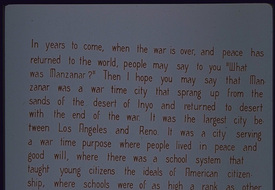
Project Director's Message, Manzanar High School Yearbook, 1944
Image ID: 4895
Collection: Roland Marchand
Topic(s): Japanese, W.W.II, W.W. II Internment
Region(s): United States
CA Standard(s): 11.7 - America's participation in World War II
National Standard(s): A Half-Century of Crisis and Achievement, 1900-1945
Card Text: Manzanar Relocation Center, message from the project director of the high school yearbook: "In years to come, when the war is over, and peace has returned to the world, people may say to you, 'What was Manzanar?' Then I hope you may say that Manzanar was a wartime city that sprang up from the sands of the desert of Inyo and returned to desert with the end of the war. It was the largest city between Los Angeles and Reno. It was a city serving a wartime purpose where people lived in peace and good will, where there was a school system that taught young citizens the ideas of American citizenship, where schools were of as high a rank as other California schools, and where students dedicated their lives to the American way of living. I hope you may say that Manzanar was an experience worth living, where the important realities of life were made clear and where there was time and opportunity to prepare for participation in the work of winning the peace based on tolerance, understanding and good will. The graduates of Manzanar have a great contribution to make in determining the kind of world that it is to become after the war. Ralph P. Merritt, Project Director." 1944.
Citation: OUR WORLD 1943-1944 (Manzanar High School Yearbook).
11.7.5
Map of W.W. II Relocation Centers
Image ID: 4896
Collection: Roland Marchand
Topic(s): Japanese, W.W.II, W.W. II Internment
Region(s): United States
CA Standard(s): 11.7 - America's participation in World War II
National Standard(s): A Half-Century of Crisis and Achievement, 1900-1945
Card Text: Map of the sites of the ten relocation centers that housed Japanese Americans during World War II.
Citation: Copyright University of Arizona Press, 355 S. Euclid Ave., Suite 103, Tucson, AZ 85719. All rights reserved. Our thanks to The University of Arizona Press. In Dillon Myer, Uprooted Americans, University of Arizona Press, 1971, p. 5.
11.7.5
Map of the Exclusion Area, Japanese Evacuation Program, 1942
Image ID: 4897
Collection: Roland Marchand
Topic(s): Japanese, W.W.II, W.W. II Internment
Region(s): United States
CA Standard(s): 11.7 - America's participation in World War II
National Standard(s): A Half-Century of Crisis and Achievement, 1900-1945
Card Text: Map of the Exclusion Area, Japanese Evacuation Program. The dotted line shows the exclusion area boundary lines. The map shows the assembly centers and relocation centers. Each exclusion area contained an evacuee population of approximately 1000 persons. 1942.
Citation: US Army, Final Report, Japanese Evacuation from the West Coast, 1942, p. 290, map insert.
11.7.5
Trucks and private cars loaded with baggage ready to leave for Manzanar , 1942
Image ID: 4898
Collection: Roland Marchand
Topic(s): Japanese, W.W.II, W.W. II Internment
Region(s): United States
CA Standard(s): 11.7 - America's participation in World War II
National Standard(s): A Half-Century of Crisis and Achievement, 1900-1945
Card Text: A caravan of trucks and private cars loaded with baggage ready to leave a control station in Los Angeles, April 28, 1942, for the Manzanar Reception Center. Evacuation was later handled by train or bus.
Citation: US Army, Final Report, Japanese Evacuation from the West Coast, 1942, p. 440.
11.7.5
Japanese American children playing football at Heart Mountain, Wyoming relocation center, 1943
Image ID: 4909
Collection: Roland Marchand
Topic(s): Japanese, W.W.II, W.W. II Internment
Region(s): United States
CA Standard(s): 11.7 - America's participation in World War II
National Standard(s): A Half-Century of Crisis and Achievement, 1900-1945
Card Text: Japanese American children playing football at the Heart Mountain, Wyoming, relocation center during World War II. 1943.
Citation: US National Archives and Records Administration, 8601 Adelphi Road, College Park, MD 20740-6001. In Roger Daniels, Concentration Camps USA: Japanese Americans and World War II, New York, 1972.
11.7.5
Boy Scout troop formed at the Manzanar relocation center, 1943
Image ID: 4910
Collection: Roland Marchand
Topic(s): Japanese, W.W.II, W.W. II Internment
Region(s): United States
CA Standard(s): 11.7 - America's participation in World War II
National Standard(s): A Half-Century of Crisis and Achievement, 1900-1945
Card Text: The Boy Scout troop formed at the Manzanar relocation center by Japanese evacuees during World War II. The troop is lined up and saluting the American flag. c. 1943.
Citation: The Franklin D. Roosevelt Library, 4079 Albany Post Rd., Hyde Park, NY 12538-1999. In Roger Daniels, Concentration Camps USA: Japanese Americans and World War II, New York, 1972. Our thanks to the FDR Library.
11.7.5
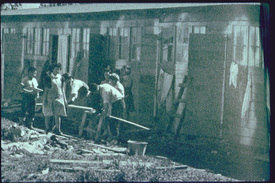
Assembly Center at Tanforan Racetrack just after the Japanese Americans moved in following removal, 1942
Image ID: 4912
Collection: Roland Marchand
Topic(s): Japanese, W.W.II, W.W. II Internment
Region(s): United States
CA Standard(s): 11.7 - America's participation in World War II
National Standard(s): A Half-Century of Crisis and Achievement, 1900-1945
Card Text: The Assembly Center at Tanforan Racetrack just after the Japanese Americans moved in following removal in World War II. "Former horse stalls were used to house Japanese Americans evicted from their homes in San Francisco. Twenty-five stalls were condemned by San Mateo County Health officials as unfit to live in, but they remained in use." - The Japanese American Museum of San Jose (JAMsj). c. 1942.
Citation: Dorothea Lange photo. U.S. National Archives and Records Administration, 8601 Adelphi Road, College Park, MD 20740-6001. In Roger Daniels, Concentration Camps USA: Japanese Americans and World War II, New York, 1972.
11.7.5
Tanforan Racetrack, 1942
Image ID: 4913
Collection: Roland Marchand
Topic(s): Japanese, W.W.II, W.W. II Internment
Region(s): United States
CA Standard(s): 11.7 - America's participation in World War II
National Standard(s): A Half-Century of Crisis and Achievement, 1900-1945
Card Text: Tanforan Racetrack two months after Japanese Americans were placed there during World War II. This photograph shows smiling children standing in front of the door. Before them is a garden plot. All improvements were made by the evacuees themselves. c. 1942.
Citation: US National Archives and Records Administration, 8601 Adelphi Road, College Park, MD 20740-6001. In Roger Daniels, Concentration Camps USA: Japanese Americans and World War II, New York, 1972.
11.7.5
Japanese American man, a World War I veteran, at Heart Mountain Relocation Camp, Wyoming. c. 1943
Image ID: 4914
Collection: Roland Marchand
Topic(s): Japanese, W.W.II, W.W. II Internment
Region(s): United States
CA Standard(s): 11.7 - America's participation in World War II
National Standard(s): A Half-Century of Crisis and Achievement, 1900-1945
Card Text: A Japanese American man, a World War I veteran, in the interior of housing located at Heart Mountain Relocation Camp, Wyoming. c. 1943.
Citation: US National Archives and Records Administration, 8601 Adelphi Road, College Park, MD 20740-6001. In Roger Daniels, Concentration Camps USA: Japanese Americans and World War II, New York, 1972.
11.7.5
Waiting to board a train at the Santa Anita Racetrack center, 1942
Image ID: 4915
Collection: Roland Marchand
Topic(s): Japanese, W.W.II, W.W. II Internment
Region(s): United States
CA Standard(s): 11.7 - America's participation in World War II
National Standard(s): A Half-Century of Crisis and Achievement, 1900-1945
Card Text: Japanese Americans during the World War II relocation, waiting to board a train at the Santa Anita Racetrack center. 1942.
Citation: US National Archives and Records Administration, 8601 Adelphi Road, College Park, MD 20740-6001. In Roger Daniels, Concentration Camps USA: Japanese Americans and World War II, New York, 1972.
11.7.5
Japanese-style landscaping, Manzanar, 1943
Image ID: 4917
Collection: Roland Marchand
Topic(s): Immigration, Japanese, W.W.II, W.W. II Internment
Region(s): United States
CA Standard(s): 11.7 - America's participation in World War II
National Standard(s): A Half-Century of Crisis and Achievement, 1900-1945
Card Text: Japanese-style landscaping, using local materials, done by William Matsuki, one of the evacuees at the relocation camp for Japanese Americans at Manzanar (CA), World War II. c. 1943.
Citation: US National Archives and Records Administration, 8601 Adelphi Road, College Park, MD 20740-6001. In Roger Daniels, Concentration Camps USA: Japanese Americans and World War II, New York, 1972.
11.7.5
The Japanese-owned
Image ID: 4918
Collection: Roland Marchand
Topic(s): Immigration, Japanese, W.W.II, W.W. II Internment
Region(s): United States
CA Standard(s): 11.7 - America's participation in World War II
National Standard(s): A Half-Century of Crisis and Achievement, 1900-1945
Card Text: The Japanese-owned "Asahi Dye Works," which was closed at the time of the Japanese-American World War II relocation. Above the window is the derisive note: "WE WON'T TAKE IT TO OWENS VALLEY FOR U." 1942.
Citation: Library of Congress Prints and Photographs Division, Washington, D.C. 20540. LC-DIG-ppmsc-09964. In Roger Daniels, Concentration Camps USA: Japanese Americans and World War II, New York, 1972.
11.7.5
Japanese-American discrimination in California, 1941
Image ID: 4927
Collection: Roland Marchand
Topic(s): Immigration, Japanese, W.W.II, W.W. II Internment
Region(s): United States
CA Standard(s): 11.7 - America's participation in World War II
National Standard(s): A Half-Century of Crisis and Achievement, 1900-1945
Card Text: Japanese-American discrimination in California, 1941. This sign outside the store of a UC-educated Japanese-American failed to protect him from race hatred. The sign reads: "I Am An American."
Citation: Dorothea Lange photo, Works Progress Administration. Still Picture Division, U.S. National Archives and Records Administration, 8601 Adelphi Road, College Park, MD 20740-6001. In Bernard A. Weisberger, The American Heritage History of The American People, 1971, p. 324.
